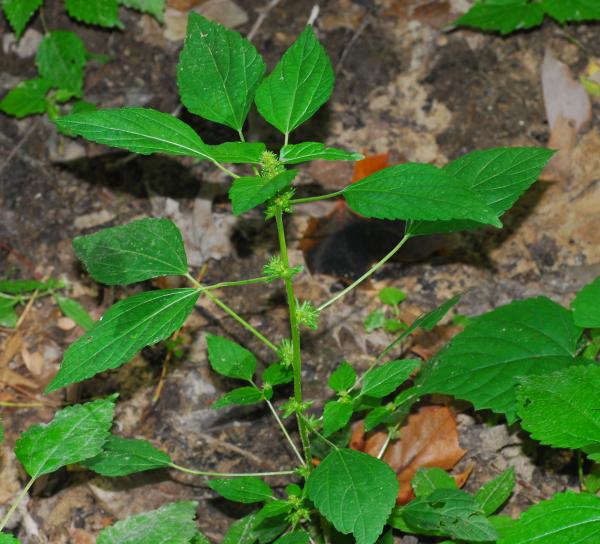Acalypha rhomboidea Raf.
Rhombic Copperleaf

Native
CC = 1
CW = 3
MOC = 64
© SRTurner
Acalypha rhomboidea Raf.Rhombic Copperleaf | |
 |
Native CC = 1 CW = 3 MOC = 64 |
© SRTurner |
|
Family - Euphorbiaceae Habit - Annual forb with clear sap. Habit - Taprooted, monoecious, annual forb. Stems - Ascending to erect, to 60 cm, branching, glabrous or moderately to densely pubescent (sometimes in vertical lines) with short, strongly curved hairs, occasionally with a few longer, straight hairs toward the base.
Leaves - Alternate, simple, long-petiolate. Petiole similar in length to the blade, much longer than the inflorescence bracts. Leaf blades 1-10 cm long, broadly lanceolate to ovate or rhombic, angled to broadly angled at the base, tapered to a sharply pointed tip, the margins with several (mostly 8-12 on each side) often relatively closely spaced, usually blunt teeth, relatively thin-textured, the surfaces sparsely pubescent with relatively straight, more or less appressed hairs.
Inflorescences - Entirely axillary spikes, 1-3 per node, each with 1-3 basal pistillate flowers below few to several nodes of staminate flower clusters, the tip of the spike not or only slightly extending beyond the bract. Bracts 4.5-25.0 mm long, appearing more or less folded longitudinally around the inflorescence, with usually 7-9 narrowly lanceolate to oblong-lanceolate lobes, the margins sparsely to moderately hairy, often some of the hairs gland-tipped, the outer surface glabrous or sparsely hairy, sometimes some of the hairs gland-tipped. Peduncles of male flowers densely antrorse-pubescent.
Flowers - Male flowers in capitate clusters terminating the peduncle. Flowers minute. Sepals 4, golden-green, antrorsely bent, 0.3 mm long, acute to blunt. Stamens many. Female flowers apetalous, the sepals minute and green. Ovary 3-locular, pubescent. Styles 3, laciniate.
Fruits - Capsules 1.5-2.3 mm long, 3-locular, 3-seeded, the surface moderately to densely hairy, lacking tubercles or slender projections at maturity. Seeds 1.3-2.0 mm long.
Flowering - July - October. Habitat - Streambanks, pond margins, bottomland and mesic forests, moist prairie depressions, fields, railroads, roadsides, other disturbed areas. Origin - Native to the U.S. Lookalikes - A. deamii, A. virginica, Boehmeria cylindrica. Other info. - This species is found throughout most of Missouri and the eastern half of the continental U.S. It is recognized as an Acalypha by the characteristic inflorescences in the leaf axils, which easily distinguishes flowering plants from Boehmeria. The very long leaf petioles differentiate A. rhomboidea from the closely related A. virginica. The plant also strongly resembles A. deamii, which is somewhat less common, and which differs in having fruits with a single seed. Unlike many plants in the Euphorbiaceae, those within the Acalypha genus do not have milky sap. Photographs taken in the Ozark Scenic Riverways, Shannon County, MO., 8-2-03 (DETenaglia); also at Pacific Palisades Conservation Area, MO, 9-22-2012; Riverfront Park, Washington, Franklin County, MO, 10-8-2015 and 8-30-2024, and Catawissa Conservation Area, Franklin County, MO, 9-11-2018 (SRTurner). |